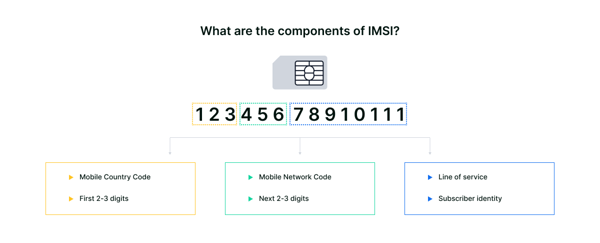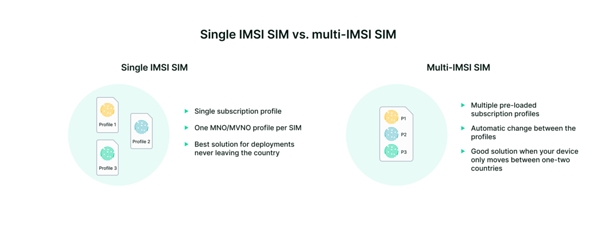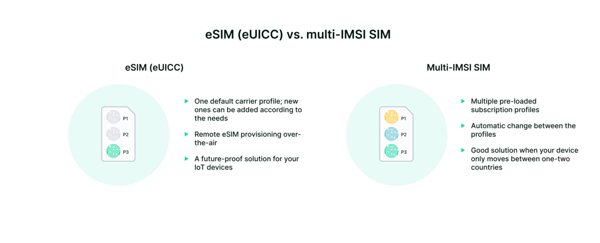With more and more companies enjoying the benefits of implementing IoT solutions in their daily operations, a smart network solution that provides greater performance, reliability, and flexibility is a must-have. Their devices need to have service wherever their customers use it and not just only where a particular carrier has coverage or roaming agreements with other MNOs/MVNOs.
One highly relevant question that has caused quite a bit of confusion among companies is whether to choose Multi-IMSI SIM or eUICC (eSIM). In this article, we focus on answering this question and share an insight into the differences between these two SIM-based solutions which can help businesses determine which one would be best for them.
What is a multi-IMSI SIM?
IMSI (International Mobile Subscriber Identity) is a unique number usually consisting of fifteen digits. The number is associated with a carrier profile to identify a cellular network subscriber. IMSI is used for acquiring information about the cellular device in the HLR (Home Location Register) and to identify, authenticate and track the subscriber in a mobile network. Due to that, the IMSI is sent as rarely as possible and a randomly generated TMSI (Temporary Mobile Subscriber Identity) is sent instead. The IMSI is used in any mobile network that connects with other networks – GSM, UMTS, and LTE networks alike.
Sometimes IMSI can be mistaken for the ICCID, which is the identifier of the SIM card itself. The IMSI is a part of the profile (or several profiles, in the case of multi-IMSI SIMs) on the SIM.
Multi-IMSI SIM is a physical SIM available in all form factors (embedded MFF2 included) that holds multiple pre-loaded IMSIs or mobile subscriptions. They are designed for accessing multiple networks and roaming applications.
You can also read about the other numbers on SIM cards.How does a multi-IMSI SIM work and how does it compare to eSIM?
As mentioned above, a static multi-IMSI SIM can hold multiple carrier subscriptions at once. These profiles are selected and pre-loaded onto a SIM card's applet during the manufacturing process and usually can’t be changed or removed afterward. The profiles on the card are always active, but the SIM card can be programmed to have a set of rules on when to choose one profile over another. For example, if a device goes from one country to another that they have a network subscription for, it can be programmed to switch to the other profile automatically.
On the other hand, an eSIM comes with one default profile, so the devices would be able to go online right after the initial deployment. Other carrier profiles can be downloaded onto the eSIM over-the-air depending on your current needs. Here it is important to note that once a multi-IMSI SIM has been inserted into the device, you don’t have any more control over it as the rules are programmed and the carrier profiles set up onto the SIM card’s system pre-deployment.
It’s not a secret that the initial eSIM platform integrations can be expensive, especially compared to the multi-IMSI SIM where you just pay for the card and are ready to go. Yet, here it is important to consider MRCs (Monthly Recurring Costs). Let’s say that you have nine different carrier profiles on a multi-IMSI SIM card, all of them constantly active because they need to be ready for an automatic switch – you have to pay for all these active profiles each month and that can prove to be quite expensive itself. On eSIM, however, you only pay for the profile that is currently in use.
There have also been some articles on the Internet stating that you have to change the API when changing a carrier profile on an eSIM, but the statement isn’t entirely correct. With 1oT’s eSIM, all profile changes and further provisioning can be done on a single platform - the 1oT Terminal Connectivity Management Platform.
Additionally, even though the device’s active MSISDN changes with the carrier profile, it usually doesn’t make a big difference, especially for IoT appliances. On 1oT Terminal, you can send text messages straight from the platform and also see the old MSISDN if needed.
Conclusion
We at 1oT strongly believe that the benefits of an eSIM outweigh the ones of a multi-IMSI SIM. While multi-IMSI SIM can seem like a cheap and reliable solution now, it isn’t necessarily future-proof.
eSIM ensures that your devices will stay connected years from now while not being influenced by the network changes or you having to worry about where the devices end up being.
To learn more about eSIM, we suggest you read our article “Everything there is to know about eSIM (eUICC)” and check out our blog post about which SIM type to choose for your deployment.
For further questions, do not hesitate to contact us at sales@1ot.com.





